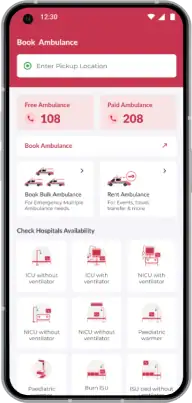Ambulance Service as a Transport Utility in Long-Distance Travel: A Viable Option?
Long-distance travel can be a challenging experience, especially when dealing with a medical emergency. In such situations, every second counts and access to medical attention can make all the difference. While conventional modes of transportation such as cars, buses or trains may be suitable for regular travel, they may not be the best options when dealing with a medical emergency. However, ambulances can be a great option for long-distance travel. Let's explore the benefits and challenges of using an ambulance service as a transport utility for long-distance travel.
Understanding the Benefits of Using Ambulance as a Transport Option for Long-Distance Travel
- Access to Medical Attention- One of the most significant benefits of using an ambulance service for transportation purposes for a long distance is access to medical attention. According to a study conducted by the Indian Journal of Critical Care Medicine, nearly 55% of road accident victims in India do not receive medical attention within the first hour of the accident, which is known as the "golden hour." Ambulances are equipped with medical equipment, medications and trained medical staff, making them suitable for transporting patients with medical emergencies. Additionally, an emergency ambulance is designed to provide comfort and care for patients during transit, which can make a significant difference in their recovery.
- Ability to Avoid Traffic and Roadblocks- Another benefit of using an ambulance service for transportation is the ability to avoid traffic and roadblocks. Ambulances are authorized to use special lanes and have the right of way in many situations, allowing them to navigate through traffic and reach the destination quickly. This feature can be especially beneficial when dealing with a critical medical emergency where every minute counts
- Safe Environment for Patients- Ambulances can also provide a safe and secure environment for patients during transit. The medical staff accompanying the patient can monitor their condition and take appropriate action if necessary. This feature can be crucial for patients who require constant medical attention or those who are at risk of deteriorating during transit
Challenges and Considerations when Using Emergency Ambulance for distant transportation
While ambulances can be a feasible alternative for long-distance travel, there are some challenges and considerations that need to be taken into account..
Ambulance Cost- One of the significant challenges is the cost of ambulance transport. Ambulance transport can be expensive and insurance coverage may not always be available. Therefore, it's essential to consider the cost implications before opting for emergency ambulance transport.
Availability- Another challenge is the availability of ambulances. Ambulance service is in high demand and it may not always be possible to find one available for long-distance transport. According to a report by the Ministry of Health and Family Welfare, India has only one ambulance per 51,000 people, which is significantly lower than the recommended ratio of one emergency ambulance per 10,000 people. Not only this but the availability of medical staff and equipment can also be a limiting factor, especially in rural areas.
Type of medical help needed- Another consideration when using an ambulance for long-distance travel is the level of medical attention required by the patient. Ambulances are designed to transport patients with medical emergencies and their primary focus is on stabilizing the patient's condition during transit. Therefore, if the patient requires advanced medical care, it may be necessary to consider other options such as air transport.






